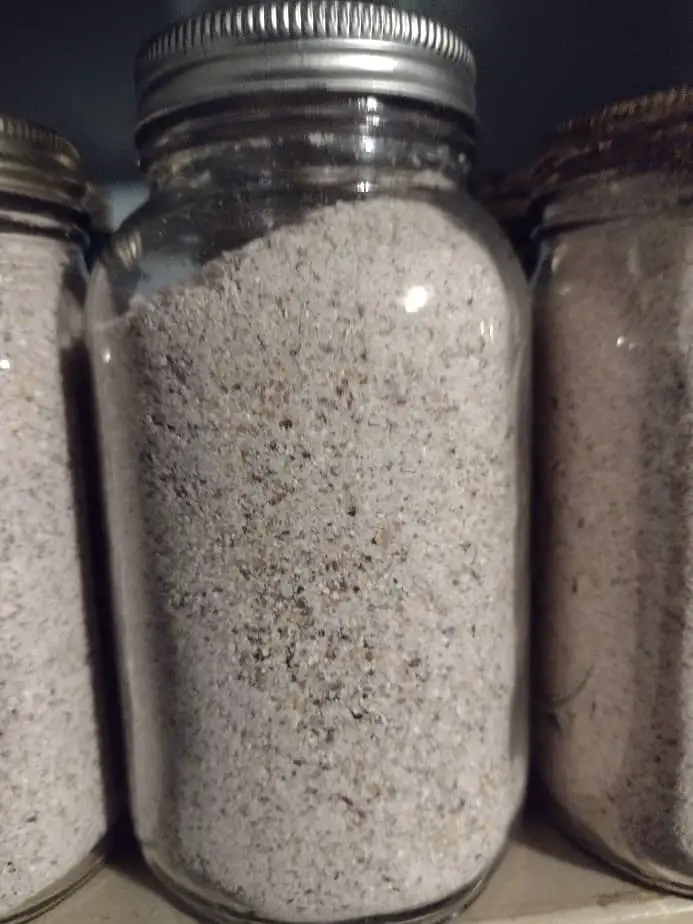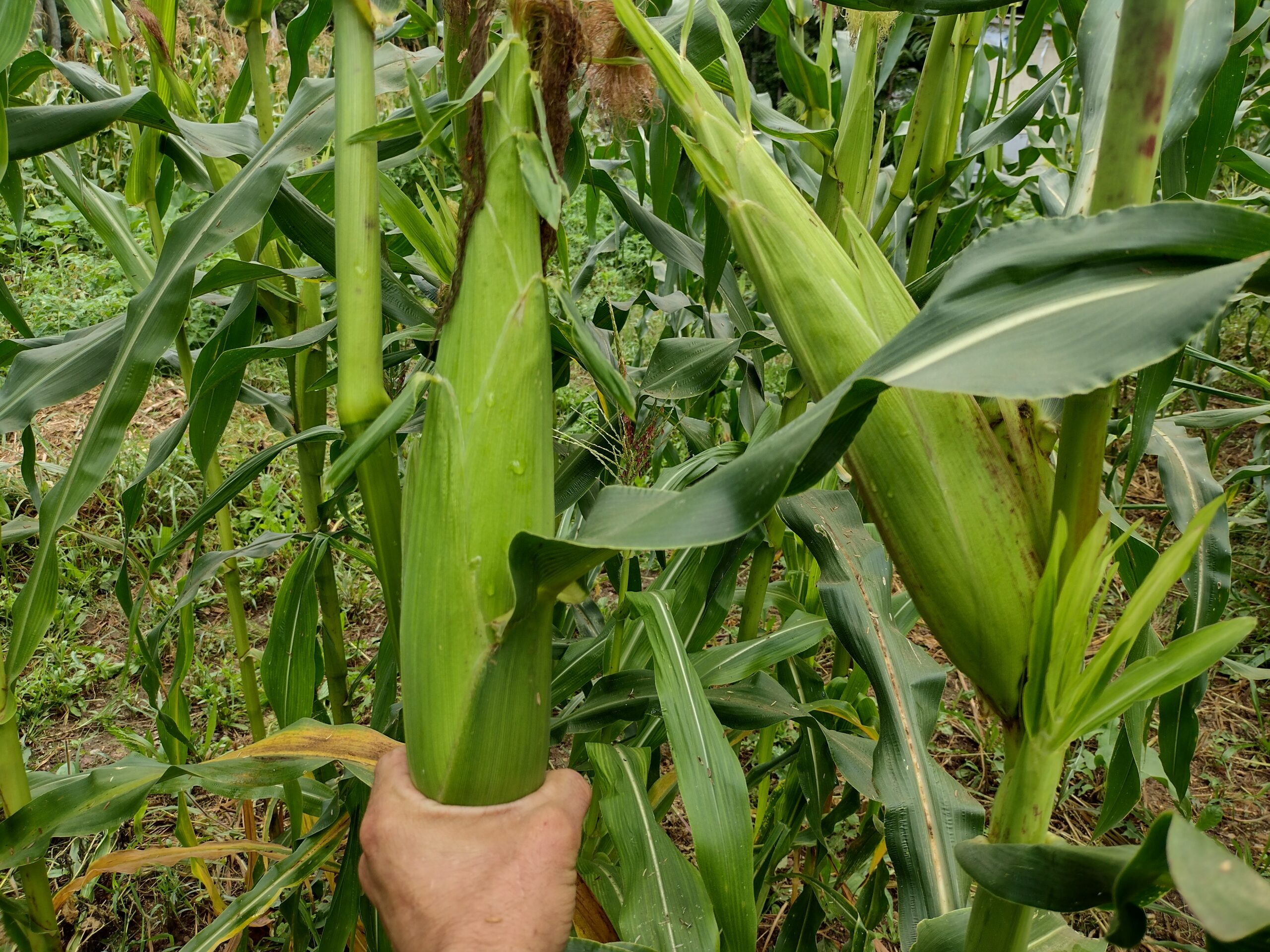Indian corn drums up ideas of fall decoration and harvest time, but native tribes grew it for food. I am planting 1/4 acre of Indian corn this year and it will be my 6th year growing corn in my front yard.
Indian corn is completely edible and makes amazing cornmeal. Whole cobs can be boiled or roasted, and most Indian corns make good popcorn. It was a staple food grain for at least 500 years in North America and many people still grow it as an heirloom food crop.
Indian corn isn’t quite like corm you’re probably used to. It’s easy to grow but it cooks differently and has a much fuller, grain-like flavor. I’ll talk you through growing, cooking, and storing Indian corn.
How is Indian Corn Different Than Regular Corn?
Indian corn has less starch and fat, and more protein and fiber than modern sweet corn or field corn. It’s bred for flavor, storage, and hardiness instead of high starch and oil, and maximum yield. Most Indian corn is a flint corn, which means the kernels are tough and will pop when heated.
Indian corn is open-pollinated, meaning it’s not a hybrid or GMO crop. Open-pollinated plants have a wider genetic variation in them. This often gives some differences in shape, size, and color in a single plant variety.
Not all true Indian corn varieties have multi-colored cobs, but that’s what people have come to expect today. Indian corn comes in all combinations of colors, including two-tone and more or less solid colored. The multi-colored tendency is because most varieties are a landrace variety.
Different seeds were planted together and seeds were saved from plants that simply did well. Nobody at the time cared about the size, shape, or color of the corn. Today, it can be hard to sell corn that isn’t large and yellow.
Indian corn, aka flint corn, is the shorter season, cooler-weather-tolerant type of corn grown by natives of North America. It was the only corn that could grow in many northern and mountainous regions before people started crossing Indian corn with another native corn known as gourdseed corn to make what we have today.
What Does Indian Corn Tase Like?
Indian corn has a very full, rich flavor. It tastes starchy, but the flavor is well-balanced. Indian corn tastes more like a grain than modern field corn and is often said to need less seasoning due to its naturally deeper flavors.
If you did a blindfolded taste test of Indian corn and regular corn, you’d be able to pick out the Indian corn. It’s definitely different and delicious. Like most varieties of heirloom corn, Indian corn is a bit tougher but has a much better flavor.

How to Cook Indian Corn
Dried Indian corn is usually ground and made into grits or cornbread. It’s delicious when picked young and cooked like sweet corn. Traditionally, dry Indian corn is roasted, called parching, then easily ground into a coarse meal.
My favorite way to eat our Indian corn is to pick ears when they are green, boil them up, and eat them with butter. Just like sweet corn, you need to pick it at the right time, usually a 2-week window, for the very best tasting corn on the cob.
You have to wait until they’ve filled out but while the plant is still producing a lot of sap. so, basically, you’re looking for about 80 percent mature corn. All you have to do is watch the color of the cornsilks, the hair tassels on the top of the ears.
As soon as the cornsilks turn brown, it’s probably ready. If you really want to know, do the fingernail test. peel back the husk on a cob just a bit and poke your thumbnail into a nice, full kernel. If a slightly milky-looking sap comes out, that’s perfect timing.
A little early or just a bit later isn’t really a deal-breaker though. You can always try a few to see just what you like best. It will be a bit firm since, unlike sweet corn, Indian corn isn’t 95% water. Indian corn still has the sweet phase, but has a much fuller taste and is significantly more filling and nutritious.
My kid’s favorite way to cook Indian corn is to grind it and make cornmeal grits. I grew up calling it cornmeal mush, but I guess most people call it grits. Being flint corn, it’s got a tough kernel when dry. It still grinds well though.
I was using my wife’s little electric spice/coffee grinder to process half a cup or so at a time, it only took 15 seconds to get a nice, fine meal. But, I burned out the motor in the cheap Walmart grinder. Now, we use the blender. It doesn’t get as consistent a grind, but after 50 pounds of corn, it’s still going fine.
You can sift your cornmeal with a stainless steel mesh kitchen strainer to get the big chunks out. I do that half the time when I have e few extra minutes. Then, you can re-grind the chunks, or just use them separately so your meal has a more texture consistent.
I’ve found that for cornmeal mush/grits, you don’t need it super fine. If there are bigger chunks in it here and there, just let it cook a bit longer and they’ll soften up to the point you can’t tell. Flint cornmeal usually has a longer cooking time, about double that of store-bought cornmeal.
I use a ratio of 1 part cornmeal to 4 parts water, then simmer it until it’s looking creamy, thick, and smooth. I love it with just a bit of salt, pepper, and thyme. My kids prefer it with diced apples and cinnamon, or with cheddar cheese.
To make Cornbread, My wife just makes it like normal and it works. You can mix the cornmeal and liquid together and let it sit an hour before finishing the batter and baking it. That way, if you didn’t get a decent grind, the larger chunks will soften up a bit more.
I’ve tried a few methods of roasting dry Indian corn. It’s very tasty if just pan-browned in a bit of oil. Depending on the variety and moisture content, kernels will pop like popcorn. The variety I grow doesn’t pop much. Browning the kernels makes them crunchy and somewhat chewable.
They can still be pretty hard though. The browned, or parched, corn grinds super easy in the blender, but I don’t think it makes a tasty cornmeal at that point.
How to Harvest and Store Indian Corn
For dry corn, Indian corn should dry as long as possible on the plant. You can further dry it after picking if the weather is wet. Fully dry kernels shatter like glass when hit with a hammer. It does well stored in buckets, plastic bags, or dry-canned in glass jars. Young corn should be canned, frozen, or refrigerated.
Where to Buy Indian Corn?
Etsy.com is one of the best places to look for Indian corn. Being a non-standard item, it’s pretty expensive to buy in bulk. I like to purchase Indian corn seeds from Baker Creek Heirloom Seeds and bulk seeds from True Leaf Market. Indian corn is a great crop to grow yourself.
Is Indian Corn Hard to Chew?
Indian corn is firmer than sweet corn but not overly hard. Whole mature kernels can be tough to cook soft. But, if ground, it cooks up very soft and smooth cornmeal grits. If boiled green on the cob, it’s pretty soft and delicious.
Can you use Indian Corn for Popcorn?
Some Indian corn makes good popcorn. While both are flint corn, it takes a very specific kernel to get a god, reliable pop. Most varieties that do well will be labeled as a type of popcorn. As long as the moisture is good, about 14 percent, an Indian popcorn should pop pretty well.
Here are some related articles:

